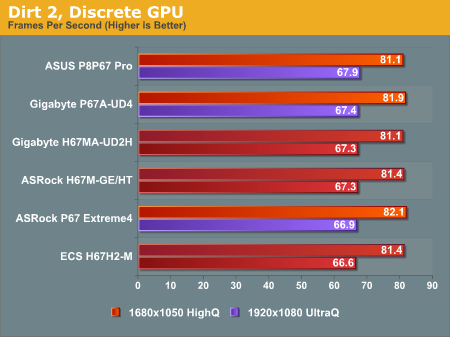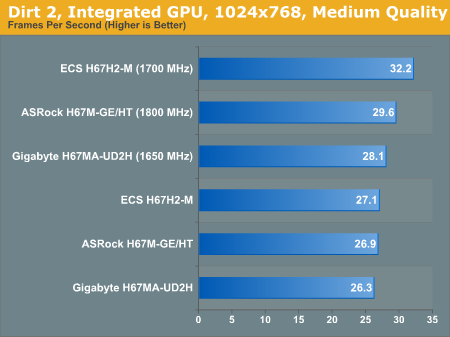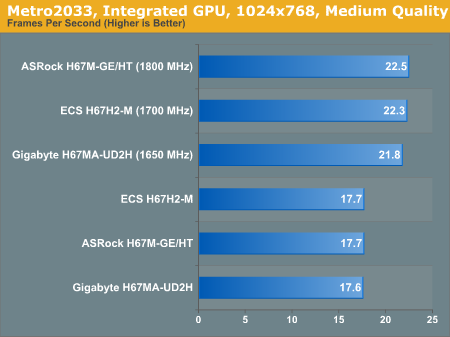H67 – A Triumvirate of Tantalizing Technology
by Ian Cutress on March 27, 2011 6:25 PM EST- Posted in
- Motherboards
- Sandy Bridge
- H67
Dirt 2
Dirt 2 came to the PC in December 2009, developed by Codemasters with the EGO Engine. Resulting in favorable reviews, we use Dirt 2’s inbuilt benchmark under DirectX 11 to test the hardware. We test two different resolutions at two different quality settings using a discrete GPU, and an appropriate integrated GPU setting.


Metro 2033
Metro 2033 is the Crysis of the DirectX 11 world (or at least until Crysis 2 is released), challenging every system that tries to run it at any high-end settings. Developed by 4A Games and released in March 2010, we use the inbuilt DirectX 11 Frontline benchmark to test the hardware.












56 Comments
View All Comments
MrSpadge - Wednesday, March 30, 2011 - link
Well done, Gigabyte! And it's a shame how poorly the others are doing in comparison. I fI wanted high power consumption I could just stick with an old machine or get an AMD..Not wanting to start a bashing / flame war. It's just that in my eyes the exceptional power consumption (especially idle) of the Sandy Bridge + IGP (plus excellent performance) is what makes it really attractive for really many roles.
MrS
trogthefirst - Thursday, March 31, 2011 - link
Actually i was torn between H67/61 and one of those 785G/880G platforms for my aunt recently - non gaming build In the end she needed multi display scalable to possibly 3-4 displays so i went with a cheapo 880G and an $70ish AthlonII X3 With the Surround View feature you could run, with a Radeon GPU up to 4 displays (2 from integrated graphics) and 2 off something like a passively cooled HD 4350/5450 Sounds like a lot of expansion, features, etc for such a cheap platform if u ask me!loimlo - Thursday, March 31, 2011 - link
Dear IanWould you like to share us with Power cumsumption measurement detail?
1. Is it DC or AC draws?
2. How do you measure the watts? From the wall plug by using Kill-a-watt?
3. Did you give not so useful MB's energy-efficiency software like ASRock IES, Gigabyte Energy Saver?
That said, I never had good experience with these softwares, especially Gigabyte one.
ShadowVlican - Thursday, April 7, 2011 - link
did you guys measure total system power consumption, or is that just motherboard? looking to build a HTPC, would love something modern and doesn't eat powertpk911 - Wednesday, April 20, 2011 - link
Intel to release Z68 chipsets in first half of MayMonica Chen, Taipei; Steve Shen, DIGITIMES [Wednesday 20 April 2011]
http://www.digitimes.com/news/a20110419PD212.html
Intel will release its Z68 chipsets in the first half of May, with Gigabyte Technology likely to be the first major motherboard maker to launch Z68-based products as soon as its embargo expires. Gigabyte's offerings will include its top-end GA-Z68X-UD7-B3 model.
Motherboard makers have also reportedly been informed that Intel will focus more on its Z- and H-series chipsets.
The share of P67-series motherboards will begin dropping once the Z68 is launched and the segment will gradually be phased out, with the P-series not being included in Intel's next generation chipsets.
...just a quick update, if I may :)
gsuburban - Sunday, February 12, 2012 - link
I wanted to upgrade from an Asus P5 series board and found most of the P8 boards had no floppy or ide (pata) interface on them. Since I still have 2 great BenQ 1655 DVD recorders, they wouldn't be usable without buying a PCI PATA card. After looking matters over I didn't see much benefit in using up 2 of 6 SATA ports since I have at least 4 hard drives and would be limited on SATA ports etc.I thought it over and discovered the P8H67-V and P8H67-M Pro by Asus still had the ide interface on board. No floppy but at least the IDE was there which would yield 6 SATA ports available without using them for the DVD-Optical.
I use XP Pro still since it does have it's advantages in some areas and not having the floppy drive is the pits as you can't load AHCI drivers via the F6 prompt in setup. I tried all sorts of ideas such as a custom image that included the AHCI drivers etc without success.
The P67 boards are totally fine and they run fast with the right CPU and memory but they are best used with Windows 7. The H67 boards save you about $250 since you don't need a video card, the boards are less than the P67's and with the select models, you get an IDE port which also frees up 2 SATA ports for those who still have IDE devices.
H67 would be my choice for high performance every day computing since the graphics are much improved from the days of G series and price is low, around $105.
I think it's too soon to eliminate the floppy and IDE interface at any rate.